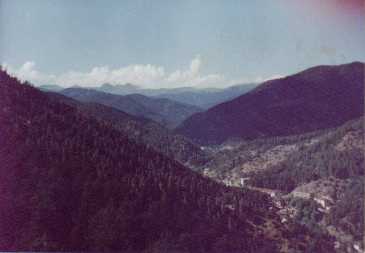
Vardzia – July 4, 1998
Vardzia is a cave city in southern Georgia, near the border with Armenia, that was built in the twelfth century by Queen Tamara. During much of its history it was used as a monastery. The city was built high in the cliffs to make it safe from invading Persians.
On Saturday morning the trip began in my car with my landlady Nona Adjiashvili, her fifteen year old son David and an analyst from the Parliament Budget Office David Shetsiruli. None of them had ever been there though it is one of the most famous ancient monuments of Georgia.
Our first stop was at the Atskuri fortress. We were driving down the highway and saw the old fortress towering above us so we had to stop. We scrambled up the hill and found a path that went inside. It was clear why the builders chose the location: it would be difficult to attack because of the steep hills on all sides and it offered a good look-out of the valley.
 |
| Abastumani |
The road was good until we got within thirty kilometers of Abastumani where we would stay with a college friend of Nona. The road deteriorated until near the village we were constantly dodging large pot holes.
Abastumani was a resort town, famous for its clear air and hot mineral baths. There were both hotels where tourists came and sanitariums for people with tuberculosis and other lung problems. These have all closed and no tourists were in sight. Now the bath house is used by the local residents for regular baths because they no longer have hot water in their homes. The town is located in a valley high in the Southern (or Lesser) Caucasus Mountains.
Nona’s friend greeted us with a fancy lunch (or early dinner, I’m not sure which!). In typical Georgian style there were a dozen or more dishes spread out on the table and everyone ate a little bit of each. David Shetsiruli and I stayed in an adjoining apartment whose owner was living in another town. The electricity was on more often than not but there was no hot water and nobody had a refrigerator.
After lunch we walked a mile or so on a path up the ridge on one side of the valley to find an old fortress from the twelfth century. People say Queen Tamara was staying here when she received word of an important victory over the Persians. I am still surprised that these fortresses have survived the centuries so well even though nobody appears to be looking after them. You just walk through the woods and suddenly there they are. We enjoyed the view then walked back down to Abastumani’s monument to World War II (known in Georgia as "The Great Patriotic War"). Every town has its monument to the war, each with a long list of citizens who died in that struggle.
That evening we drove up a long, winding road to the Abastumani Observatory. It has half a dozen large telescopes and many scientists still live and work there. There is a cable car that goes from the village to the observatory, but it doesn’t run at night. Nona introduced us to a friend who lives there with his family. He said that the government did not provide any money for new equipment but that he had a grant from the Soros Foundation that let him carry on his research. It stayed light until after ten o’clock, but when it finally was dark he showed us one of the telescopes. The moon was almost full, so it was not a good night for star gazing, but he did show us the moons of Jupiter.
The next morning Nona’s friend joined us as we headed for Vardzia. Our first stop was Akhaltsikhe (New Castle). We explored the market there and I bought an Eric Clapton cassette for a couple dollars. It looked as though the town is more prosperous than most but I don’t know how people earn a living.
The next stop was the Khertvisi fortress. It was an ominous and impressive castle.
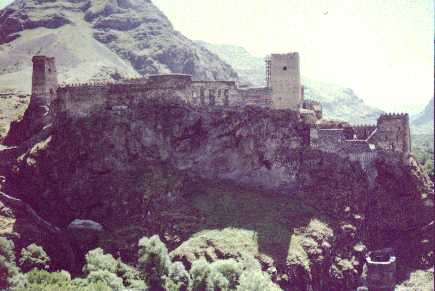 |
| Khertvisi |
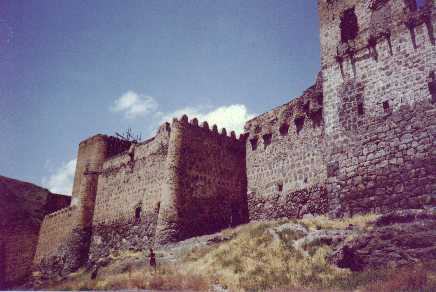 |
| Khertvisi |
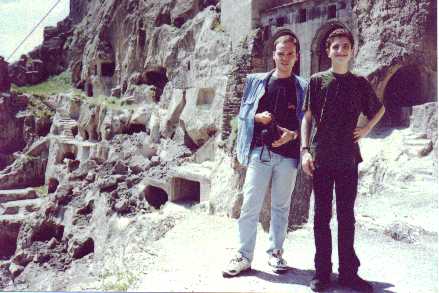 |
| Vardzia Cave City -- David Shetsiruli and David Adjiashvili |
 |
| Vardzia Cave City |  |
| Vardzia Cave City | 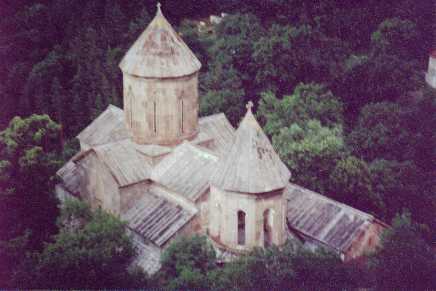 |
| Sapara Monastery |
As we headed for Vardzia it was clear that the whole climate had changed. Abastumani was lush and green but to the south and east of Akhaltsikhe there were few trees and even the grass was brown. As we got closer to Vardzia I was reminded of the badlands of South Dakota – not a good place for a hike. There were steep cliffs everywhere, many with caves carved into them.
At Vardzia there was a large parking lot and we paid for admission tickets but declined the offer of a guide. We walked on a path several hundred feet up the cliff. There were hundreds of rooms on the side of the cliff and there had been many more, but over the centuries parts of the cliff have fallen to the valley below. After we had explored for a while we were joined by a young man studying to be a priest who proudly explained about the caves and their history. He showed us the old chapel with a passageway to a spring.
We had a fine picnic lunch on a field between the parking lot and the river then headed back toward Abastumani. We stopped in Akhaltsikhe for khinkali, Georgian dumplings. Then we went to look for the Sapara monastery. Georgians never put their monasteries in the center of towns! We drove up into the hills until we came upon it. We parked outside the gate and went in to find a service taking place. There was some chanting from an assistant to the Priest, then the Priest brought out a big book and did his own chanting. There were about a half dozen people in the service, most of them residents of the monastery. (If you want better attendance your church probably needs to be closer to the villages!) Outside the church, but still within the walls of the monastery we climbed up a hill to an old castle. It didn’t seem to have a door or gate. I don’t know how anyone ever went in.
We drove back to Abastumani and went to the bath house. Each person got their own room with natural hot water in a big bathtub. The water just keeps coming, twenty-four hours a day. It was very relaxing.
When we woke up the next morning it was raining, so we relaxed in the apartment.
On the way home on the map we saw a fortress called Nedsvi that appeared to be right next to our highway. We asked people how to get there and nobody gave clear directions but they pointed us on our way. The dirt road turned to mud and crossed several streams. One of them looked as though it might be too deep for the car, but David Adjiashvili showed that he could walk across it. We kept wandering deeper into the woods and asking directions of everyone we saw. Finally we found some ruins of a church in the woods next to the road, but there wasn’t really much to see. I was pleased to make it out without getting the car stuck.